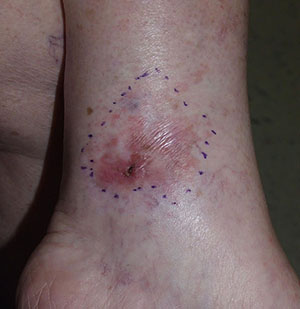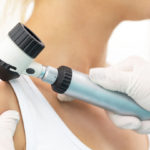You’re may not be the type of person to run to the doctor for every little thing, and are you normally prone to worrying. However, you really don’t like the looks of that mole. Could you have skin cancer?
Alphabet Soup
An unremarkable mole has even coloring, whether that’s brown, black, or tan. It can have a raised or flat appearance on your skin and be either oval or round. Most people acquire moles during childhood that remain in place for the rest of their life. Dermatologists consider moles that first appear in adulthood to be suspicious and urge people to have them checked out right away. You may think it isn’t a big deal and you could be right. However, we always encourage people to be proactive rather than reactive.
It is also helpful to keep the ABCD rule in mind when deciding if you should be seen for a suspicious mole. That means you should consider the following:
- Asymmetry: A normal mole has symmetrical sides. The two sides of a potentially cancerous mole do not match one another.
- Border: Look at the edges of your mole. If they are blurry, ragged, or otherwise irregular, please schedule an appointment in our medical dermatology department.
- Change: A mole that changes over time in any way – whether that’s size, color, or shape – is also suspicious and should be checked out immediately.
- Color: Another “C” is Your mole should be one consistent color. If you have basal cell, squamous cell, or melanoma type of skin cancer, it may appear brown or black with shades of blue, red, white, or pink mixed into it.
- Dark: A dark mole (brown or black) or a lighter mole that darkens is also one possible sign that the mole is becoming cancerous and could be a melanoma.
- Diameter: Another important “D” is The typical mole is one-quarter of an inch in diameter or less, although some forms of melanoma skin cancer can be smaller.
Always alert your dermatologist if a mole or other skin lesion bleeds or fails to heal within three to four weeks. A pattern of repeated crusting or open wounds inside a lesion could be the first sign of skin cancer.
At Dermatology Associates, Dr. Collins also uses the “ugly duckling sign” to aid in the recognition of skin cancer. The ugly duckling (pictured below) has an outline shape similar to a duck, and will look different from the other moles on your body. It usually differs in size, shape or color.

Finally, amelanotic melanoma can be pink or flesh colored and doesn’t really seem to fit any of the classic “ABCD” criteria.” These are the most difficult to identify due to the relative lack of melanin pigment. A new, growing, papule or bump in the skin should raise suspicion, but it may be flat and not easily recognized. A skin biopsy reviewed by a dermatopathologist is suggested if there is any doubt about the possibility of cancer.
Treatment of Cancerous Moles
Basal cell carcinoma is the most common and easiest type of skin cancer to treat, followed by squamous cell carcinoma. If you have either of these, your dermatologist will most likely remove it in an outpatient procedure called Moh’s surgery. This prevents the spread of cancer cells.
Melanoma is the most serious type of skin cancer, but it has an excellent recovery rate if caught early. It is difficult to treat once it has spread to other organs of the body. That is why regular skin checks and prompt follow-up with a medical dermatologist are so essential.
Moles are perfectly harmless in most cases. However, they need to be removed if any type of cancer is present. While we understand the prospect can be scary, early detection means a less invasive procedure.
At Dermatology Associates, we take your moles seriously. If you’d like to schedule an appointment for a mole check, just click here.
Dermatology Associates offers a full spectrum of leading edge medical, surgical, and cosmetic dermatology services from offices in Savannah and Vidalia.


